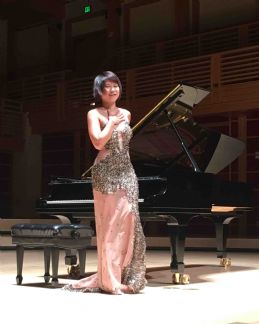|
Recital
ELEGANT VOCAL MASTERY AT ROSES SIGNATURE RECITAL
by Pamela Hicks Gailey
Sunday, February 25, 2024
Recital
DEMANDING SCHUMANN WORK IN MUSIC AT OAKMONT RECITAL
by Terry McNeill
Thursday, November 9, 2023
Recital
RARE RAVEL IN MENDO FESTIVAL'S PRESTON HALL
by Terry McNeill
Thursday, July 20, 2023
Recital
FRENCH FLAVOR IN RARE FOUR-HAND RECITAL
by Judy Walker
Sunday, January 15, 2023
Recital
ASSERTIVE PIANISM IN YAKUSHEV'S OCCIDENTAL RECITAL
by Terry McNeill
Sunday, November 13, 2022
Recital
HEROIC LIM PERFORMANCE AT STEINWAY SOCIETY RECITAL
by Abby Wasserman
Sunday, September 18, 2022
Recital
AGGRESSIVE PIANISM IN MYER'S MENDO FESTIVAL RECITAL
by Terry McNeill
Thursday, July 14, 2022
Recital
UNIQUE ELEGANCE IN GALBRAITH GUITAR RECITAL
by Gary Digman
Friday, April 29, 2022
Recital
ALLURING GLASS WORKS IN WEILL RECITAL
by Terry McNeill
Friday, March 25, 2022
Recital
FORGOTTEN BACH SHINES IN YARDEN'S OAKMONT RECITAL
by Terry McNeill
Thursday, March 10, 2022
|
 |
 Yuja Wang at Weill Hall. (Photo by Susan Dzieza.) |
AT THE BOUNDARIES OF MUSICAL EXPLORATION
by Sonia Morse Tubridy and Nicki Bell
Friday, May 6, 2016
On May 6 at Weill Hall, pianist Yuja Wang gave a much-anticipated recital of Brahms, Schumann and Beethoven. This young artist has been heralded internationally for her brilliant virtuosic technique and sensational performances. In this recital, her first to focus on a Beethoven sonata, she played his monumental "Hammerklavier" (op. 106), as well as Brahms' Ballades (Op. 10, Nos. 1/2) and Schumann's "Kreisleriana."
Wang began with the Brahms with the first Brahms Ballade, nicknamed "Edward" after a Scottish murder ballad. The opening was hushed and brooding, with Wang's fingers evoking vast spaces and sorrow, but also consolation and peace. It was magical sound painting with remarkable dynamic control. From the first quiet chord, Wang pulled the audience of around 1,000 with her to a place of intensely focused attention, swelling to loud and heavy chords and then back to whispers of sound.
The second Ballade brought the light of a major tonality in rising figures over a murmuring tide-like bass pattern. An ominous sixteenth-note pattern interrupts the delicate flow, leading to a vigorous gallop and then back to a sense of beauty and peaceful joy. This music was intimate and thoughtful, every sound meaningfully reflecting the depth of the composer's spirit. Wang could sing with gentle softness and contrast this with thick chords of great drama. Particularly moving were a beautiful tenor melody and masterful layering of sounds.
Schumann's Kreisleriana was in part inspired by an ETA Hoffman story about a composer named Kreisler who is not appreciated by "philistines" who just want light entertainment. The piece features Schumann's two contrasting musical personality types: Florestan and Eusebius. Fiery Florestan bursts forth, but Eusebius is relaxed, contemplative and dreamy. Wang succeeded in creating the different voices, growing out of each other, complementing inner dialogues and a sense of exploration. Grotesque and lyrical sections emerged, capriciousness and poetic song followed each other. Wang's artistry was exquisite and led to precious moments when pianist, instrument and listeners become immersed in an enveloping musical consciousness. When the story reached an end, Wang concluded with charm and humor. The pianistic clarity was a delight.
The second half of the program consisted entirely of the Hammerklavier sonata, composed by Beethoven in a period of great personal anguish culminating in the suicide of his beloved nephew. It is a forbidding challenge, both technically and musically. The opening chords of the Allegro, with their dotted rhythms, were suitably heroic and quickly dissolved into small groupings of motives that were constantly transformed, sometimes sounding like free improvisations and other times being pulled back to strict form. Wang used the enormous range of her instrument to create full orchestral sounds, deep rumbles, ethereal floating pitches, wild outbursts and calm sections, often simultaneously.
The fierce Scherzo, punctuated by furious repeated octaves, led to the Adagio, the heart of the sonata. This started with simple understatement and then increasing inner motion, leading to transcendental conciliation. The bridge at the end leads through uncertainty to the Finale, a fugue in three voices. The movement is a tour de force of composition, requiring of the performer virtuosic leaps, trills and furious tempi, all while managing a lengthy 108-note fugal subject.
A great performance of the Hammerklavier can grab the audience and carry it to the edge of madness until the final solid chords set them down on firm land, forever altered. Wang was up to this task. She played with courage, fire and a mature understanding of this unique and transformative sonata.
Thunderous applause had Wang return for four entertaining encores, seriousness eschewed for the complex rhythms of Kapustin's Toccata. Then two transcriptions: the Gluck/Svengeti "Dance of the Spirits" and the Schubert/Lizst "Gretchen am Spinnrade." The final encore was a humorous, jazzy arrangement of Mozart's "Rondo alla Turk" by Volotus. Wang's spirited pleasure in her own formidable abilities marked a lighthearted end to a serious and emotionally demanding program.
|

